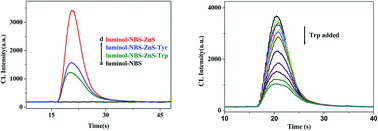Determination of tryptophan and tyrosine by chemiluminescence based on a luminol–N-bromosuccinimide–ZnS quantum dots system†
Abstract
In this work, water-soluble ZnS quantum dots (QDs) modified with 3-mercaptopropionic acid (MPA), L-cysteine (L-Cys) and thioglycolic acid (TGA) were synthesized. The nanostructure and optical properties were characterized by X-ray powder diffraction (XRD), Transmission electron microscopy (TEM), UV-Vis absorption spectrum and fluorescence spectrum. Through the study of the ZnS QDs effects on the chemiluminescence (CL) system of luminol, we found that ZnS QDs could obviously enhance the CL of the luminol–N-bromosuccinimide (NBS) system in an alkaline medium. At the optimal experimental conditions, we researched the impact of 17 kinds of amino acids on this system. It was found that L-tryptophan (Trp) and L-tyrosine (Tyr) had significantly inhibitory effects on luminol–NBS–ZnS QDs CL. Based on the inhibitory effects, a novel CL method with a wider linear range and lower detection limit for determination of Trp and Tyr was developed. The detection limits were 1.5 × 10−11 g mL−1 and 2.0 × 10−10 g mL−1, respectively. The possible CL reaction mechanism was also discussed briefly.


 Please wait while we load your content...
Please wait while we load your content...